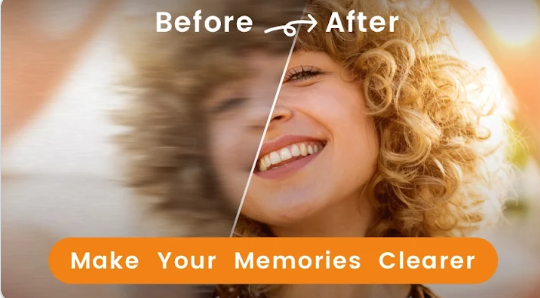Discover how an AI picture enhancer can transform your images with artificial intelligence, delivering sharper details, richer colors, and professional-level quality in seconds. Perfect for photographers, designers, and anyone who wants stunning visuals without manual editing.
What is an AI Picture Enhancer?
An AI picture enhancer is a smart image-editing tool powered by machine learning algorithms that automatically improves photo quality without the need for complex manual adjustments. By analyzing every pixel, it can sharpen details, restore clarity, and enhance colors to make your images look professionally edited.
Unlike traditional editing software that requires time and skill, these tools use deep learning technology to identify imperfections such as blur, low resolution, or poor lighting, and then apply corrections instantly. Whether you’re a photographer, e-commerce seller, or just someone who wants flawless social media posts, an AI picture enhancer offers an effortless way to upgrade your visuals.
In 2025, this technology has become more advanced, allowing even beginners to transform ordinary images into high-quality masterpieces with just one click. It’s not just about editing — it’s about bringing photos to life in a way that’s both fast and affordable.
2. How AI Picture Enhancers Work
An AI picture enhancer works by combining computer vision, deep learning models, and image processing algorithms to automatically improve the quality of your photos. The process starts when the software scans the image, breaking it down into millions of tiny data points, also known as pixels. These pixels are then analyzed to detect imperfections such as noise, blurriness, color imbalance, or low resolution.
The AI uses pre-trained neural networks that have learned from millions of example images. This means it “knows” what a sharp, vibrant, and well-lit photo should look like. By comparing your image to its learned patterns, the tool can intelligently adjust contrast, brightness, sharpness, and color saturation — all without the user having to tweak individual sliders.
Some advanced tools also use super-resolution technology, which reconstructs missing details and allows you to upscale images without losing clarity. Others employ GANs (Generative Adversarial Networks) to recreate realistic textures and fine details that were never captured in the original photo.
In short, AI picture enhancers mimic the decision-making process of a professional editor, but they do it in seconds, ensuring every photo gets a polished, high-quality finish with minimal effort from the user.

3. Benefits of Using AI for Image Enhancement
Using an AI picture enhancer offers a wide range of advantages for both professionals and casual users. Here are some of the biggest benefits:
- Time-Saving – AI can process and enhance hundreds of photos in seconds, eliminating the need for hours of manual editing.
- Consistent Quality – Every image gets the same professional-grade treatment, ensuring brand consistency for businesses.
- Automatic Corrections – Instantly fixes issues like poor lighting, low resolution, or lack of sharpness.
- Cost-Effective – Reduces the need for hiring professional editors for basic enhancements.
- Advanced Restoration – Revives old or damaged photos by removing scratches, correcting faded colors, and restoring clarity.
- Easy to Use – Most tools require just a single click, making them accessible for beginners.
- Versatile Output – Works for social media posts, e-commerce product photos, portfolio images, and personal photography.
By leveraging these benefits, users can consistently produce high-quality, visually appealing images without investing heavily in editing skills or expensive software.
4. Popular AI Picture Enhancer Tools in 2025
The market for AI-powered editing tools has exploded in recent years, with a variety of software and online platforms offering advanced enhancement features. Some of the most notable AI picture enhancer tools in 2025 include:
- Remini – Known for its ability to upscale and restore old, blurry, or low-resolution images with remarkable detail.
- Topaz Gigapixel AI – Specializes in enlarging images without losing quality, perfect for prints or high-resolution displays.
- Let’s Enhance – An online platform that uses deep learning to improve image sharpness, color balance, and texture detail.
- Luminar Neo – Offers AI-based editing alongside traditional photo editing tools for more creative control.
- Fotor AI – A beginner-friendly online editor with a variety of one-click enhancement options.
- Adobe Photoshop Neural Filters – Integrated within Photoshop, these filters use AI to retouch, colorize, and adjust images intelligently.
Each of these tools brings its own strengths, from restoring old family photos to optimizing e-commerce product shots. When selecting the right AI picture enhancer, consider your primary needs — whether it’s upscaling, color correction, or detailed retouching — and choose a platform that balances ease of use with advanced functionality.
5. AI vs. Traditional Photo Editing
When comparing AI picture enhancers to traditional editing methods, the key differences lie in speed, accessibility, and skill requirements.
- Speed – Traditional editing often requires hours of manual work in software like Photoshop, while AI tools can achieve similar results in seconds.
- Skill Level – Manual editing demands a deep understanding of layers, masks, and adjustments; AI tools are beginner-friendly with automated corrections.
- Consistency – Human editing quality can vary depending on the editor’s skill and mood, whereas AI applies the same enhancements every time.
- Customization – Traditional editing allows for unlimited creative control, while AI, although improving, still works within pre-set algorithms.
- Cost – Professional editing services can be expensive, while AI tools offer affordable subscriptions or even free versions.
While AI picture enhancers are excellent for quick and consistent results, they might not completely replace traditional editing for specialized creative projects. Many professionals now use a hybrid approach — starting with AI for basic improvements, then fine-tuning manually.
6. The Technology Behind AI Picture Enhancers
At the core of every AI picture enhancer lies advanced machine learning and neural network technology. These systems are trained on vast datasets containing millions of images in different lighting conditions, qualities, and resolutions. Over time, the AI learns to recognize patterns of what makes an image clear, vibrant, and visually appealing.
One of the most powerful technologies used is Convolutional Neural Networks (CNNs), which excel at detecting edges, shapes, and textures in photos. By understanding these elements, the AI can apply targeted enhancements — for example, sharpening the edges of a subject while keeping the background smooth.
Another innovation is Generative Adversarial Networks (GANs). GANs work in pairs: one network generates a new image based on the original, while the other evaluates it for realism. This process continues until the output is nearly indistinguishable from a naturally high-quality photo.
Some platforms also integrate super-resolution algorithms that reconstruct missing details, allowing for upscaling without pixelation. Others employ color grading AI models that analyze the mood and tone of a photo, then adjust hues, shadows, and highlights accordingly.
In simple terms, these AI tools don’t just apply filters — they understand the structure and content of an image, making enhancements that feel natural rather than artificial.

7. Use Cases for AI Picture Enhancers
The versatility of an AI picture enhancer means it can be applied in countless scenarios across personal, professional, and creative fields. Some of the most popular use cases include:
- E-commerce product photography – Online sellers can instantly improve product images, making colors more accurate and details sharper, which boosts buyer trust and conversions.
- Social media content – Influencers and marketers can create high-quality visuals without expensive gear, keeping their feeds consistent and eye-catching.
- Real estate listings – Property images can be brightened, sharpened, and color-corrected, helping attract more potential buyers or renters.
- Photography restoration – AI can bring old or damaged photos back to life by repairing scratches, restoring faded colors, and enhancing clarity.
- Marketing and advertising – Brands can ensure every campaign image meets professional standards, regardless of the original quality.
- Travel photography – Travelers can transform dull vacation photos into vibrant, share-worthy memories with minimal effort.
In essence, whether you’re a business owner, creative professional, or casual user, an AI picture enhancer provides a quick and cost-effective way to elevate your visual content.
8. Future of AI in Photo Enhancement
The future of AI picture enhancement looks incredibly promising, driven by rapid advancements in machine learning and computational photography. Over the next few years, we can expect tools to become even smarter, faster, and more personalized.
One emerging trend is real-time enhancement, where images are improved instantly as they’re captured, eliminating the need for post-processing. This could be integrated directly into smartphone cameras and AR devices, making high-quality photos the default.
Another exciting development is context-aware editing, where AI will not only recognize objects but also understand the scene’s mood and purpose. For example, it could enhance a food photo differently from a landscape, applying adjustments that suit each scenario perfectly.
AI models are also expected to become more ethical and transparent, reducing over-editing that distorts reality and ensuring authenticity in journalism and professional work. Additionally, cloud-based AI tools may give users collaborative editing options, where teams can work on the same image simultaneously with AI assistance.
With continuous training on larger datasets, tomorrow’s AI picture enhancers may reach a point where they not only match human editors in skill but also predict trends and styles before they become popular — giving users a creative edge.
9. Choosing the Right AI Picture Enhancer
With so many tools available, picking the right AI picture enhancer can feel overwhelming. The best choice depends on your needs, budget, and preferred workflow. Here are some key factors to consider:
- Image Quality Output – Look for a tool that delivers sharp, natural-looking results without over-smoothing or creating unnatural artifacts. Test sample images before committing.
- Speed and Performance – If you process large batches of photos, opt for a fast, cloud-based AI tool that can handle multiple files at once without slowing your device.
- Supported Formats – Ensure the software supports common file types like JPEG, PNG, TIFF, and even RAW files if you’re a professional photographer.
- Customization Options – While AI automation is great, the ability to manually tweak brightness, contrast, or saturation can help fine-tune results.
- Special Features – Some tools include extras like background removal, face retouching, or super-resolution upscaling — handy for specific needs.
- Pricing and Licensing – Free tools can work well for casual use, but for professional quality and advanced features, consider a paid plan with flexible licensing.
- Device Compatibility – Check if the enhancer works on your operating system, smartphone, or integrates with your favorite editing software.
By comparing these features, you can find an AI picture enhancer that fits your style and goals, whether you’re creating social media content, selling products online, or preserving memories.
10. Tips for Getting the Best Results with AI Picture Enhancers
Even though AI does most of the heavy lifting, a few smart practices can help you get the most out of your AI picture enhancer:
- Start with the highest quality source image – The better the input, the better the AI’s output. Avoid blurry or extremely low-resolution photos when possible.
- Use enhancements in moderation – Over-processing can make images look fake. Aim for natural, balanced improvements.
- Understand your goal – Are you optimizing for web, print, or social media? Adjust settings accordingly for size, resolution, and color profile.
- Leverage batch processing – If you have multiple images, process them together to save time and maintain consistent quality.
- Experiment with different tools – Each AI picture enhancer has unique strengths; try a few to find the one that best suits your style.
- Manually fine-tune when needed – AI is smart, but your creative touch ensures the final image aligns with your vision.
- Keep an unedited backup – This allows you to revert or try different enhancement styles without losing the original photo.
By combining AI efficiency with thoughtful editing habits, you can consistently produce professional-grade visuals that stand out.
Conclusion
The rise of the AI picture enhancer is transforming the way we edit and experience images. From restoring cherished old photos to creating scroll-stopping content for social media, AI makes high-quality editing accessible to everyone — not just professionals.
As technology evolves, these tools will only become faster, smarter, and more intuitive, making them an essential part of any creative toolkit. Whether you’re a photographer, marketer, business owner, or hobbyist, embracing AI-powered editing is a step toward producing visuals that truly captivate your audience.
In a world where images speak louder than words, the right AI picture enhancer can turn a simple snapshot into a masterpiece.



